We
have received numerous comments, most then anonymous, about our coverage of the
Pacifica Foundation, WBAI and the future of the noncommercial organization.
Many of the comments deal with the endless feuds between various factions. We
avoid reporting on these matters because they ultimately don’t matter.
One
comment from an anonymous Spark News
reader did catch our attention because it touches on a current topic: Manhattan
Neighborhood Network’s (MNN) offer to take over WBAI with a Public Service Operating
Agreement (PSOA). Dan Coughlin is the
CEO of MNN and has a deep and murky history with Pacifica.
We
reported about MNN on February 5th [link]. Here is the comment we
received:
"Here are some other fun
facts about Dan Coughlin [the head of MNN]. He was
an ally of Amy Goodman’s when he was a reporter for Pacifica’s national news
(Pacifica Radio News)."
 |
| Dan Coughlin |
"Along with the hundreds
of thousands of dollars poured into a professional public relations campaign
(The Pacifica Campaign) against the then Pacifica board during the lawsuits of
1999-2002, run by Amy Goodman and Juan Gonzalez, Coughlin was part of the news
department who went on strike to support Goodman in the ginned up attack on the
board."
"When the board was finally forced out, Coughlin was appointed [Executive Director] by Goodman. Coughlin signed off on Goodman’s contract-of-a-lifetime which gave her for free all of Pacifica’s intellectual property to Democracy Now!, a show created by WBAI. Although she now claims she created the show she did not and was not its original host. Since 2002, Pacifica has been in the position of renting back the radio show it created and paying its former employee, Goodman, hundreds of thousands of dollars."
KEN SAYS: Because Amy Goodman is
reportedly a very litigious individual, so we will be very careful talking about
her. Therefore, in the information below, we will
label factual information “Fact” and
disputed allegations as “Rumor.” In a quick nutshell, here is the backstory:
(Fact) Democracy Now! began as a local program on WBAI in February 1996.
The host was Amy Goodman who started working at WBAI as a volunteer in the
1980s. After early success on WBAI, Democracy
Now! went into national syndication. At that time the program was owned and
financially supported by the Pacifica Foundation.
 |
| Goodman recently on CNN |
(Fact) Goodman quickly became a
well-known commentator on cable TV shows and frequently appeared as an expert
regarding political and social issues.
(Fact) Democracy Now! became the number one fundraiser for Pacifica and
it’s stations. By one estimate Democracy Now! generated 25% of Pacifica’s total
revenue.
 |
| Steve Yasko |
(Fact) In 2000, Pacifica hired former
NPR marketing manager Steve Yasko to be its National Program Director. See our
August 2015 coverage [link] for
background.
Pacifica’s National Board brought in Yasko to upgrade the network’s
programming. Yasko technically became Goodman’s boss. Things didn’t go well and
Yasko’s job became a journey into the Rings
of Hell in Dante’s Inferno.
 |
| Amy Goodman and Juan Gonzalez |
(Fact) Goodman resisted Yasko’s
oversight and input. Yasko
was eventually driven out of Pacifica by a smear campaign allegedly mounted by
Goodman and Juan Gonzalez, a Goodman associate who is now a co-host of Democracy Now!
(Fact) In mid-August of 2000, Goodman
publically said she could no longer work for Pacifica. She threatened to boycott
fundraising for Pacifica. Her threats caused panic within Pacifica and
affiliated stations nationwide.
(Fact) In 2001, Goodman
publically announced that she would quit Democracy
Now! unless Pacifica turned over ownership of the show to Goodman’s private
corporation, free of charge.
(Fact) Pacifica naively caved
to Goodman’s demands and gave Democracy
Now! to her. The deal also gave Goodman ownership of the program’s
archives, intellectual property, and confidential donor lists. Pacifica also
granted Goodman the right to fundraise for Democracy
Now! rather than Pacifica.
(Fact) In the agreement with
Goodman, Pacifica agreed to pay Goodman $500,000 per year to continue
broadcasting Democracy Now!
(Rumor) Dan Coughlin, Pacifca’s
Executive Director in the early 2000s, engineered and facilitated Goodman’s
takeover of Democracy Now! Coughlin
is currently the CEO of MNN. MNN is now working aggressively to take over WBAI
via a PSOA.
(Fact) According to Democracy Now’s IRS 990 for FY 2015, the
most recent year available, Pacifica then owed Goodman’s corporation
$1,875,000. In FY 2015 Democracy Now!
had annual revenue over $8 million and net assets worth almost $20 million.
(Fact) Meanwhile Pacifica is on
the verge of being forced into Chapter 7 bankruptcy. Pacifica’s debts reportedly exceed $8
million including the money owed to Amy Goodman.
KEN’S OPINION: Two words
come to mind: Gullible and Hypocrite.
It
is hard to believe how gullible and naïve the leadership of Pacifica was then
and probably still is today. Because the organization’s Board members are
chosen for their political and social bonafides, not their business sense or
experience in radio, they are open prey for kooks, game-players and bandits.
It
is also hard to believe the hypocrisy displayed by Amy Goodman. On her show, she
rails about corporate greed and malfeasance while she uses tactics that are
more greedy than those used by Wall Street takeover pros.


































